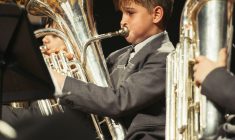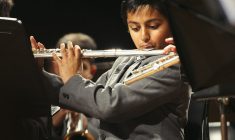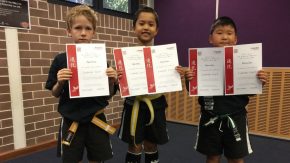Music
Instrumental Programs
All the boys in Years 2, 3, 4 and 5 have made a start on the instrumental program this year.
The boys in Years 2 and 4 and some boys in Year 5 have begun learning a new instrument. For these boys it is always a challenge – to create a sound, to hold the instruments correctly and to progress at a steady rate. After the initial excitement of getting the instrument keeping the momentum going is really important. Playing a little bit every day, asking your son what he is going to focus on, trying to eliminate the barriers of getting instruments out are all ways of supporting your son in learning an instrument.
Anita Collins is a researcher who has made a study of neuroscience and learning music. She has many interesting articles. She has looked at what learning a musical instrument does to a brain. Anita has analysed what students need to do to play a musical instrument.
To get the correct note out of an instrument at the right time is an “incredible cognitive accomplishment….the brain needs to coordinate the motor, visual and auditory cortices to produce just one correct note.” Think about what they need to do to play a piece made up of different notes.
In rehearsals, it can at times be very frustrating – boys not being able to play a piece at the same tempo (speed), boys not being able to play the piece at the tempo that the conductor wants it to be played at. Dealing with these emotions is a learning skill in itself.
Here are some fantastic videos that I have used in the classroom. They are very accessible for the boys to watch
http://www.anitacollinsmusic.com/resources/
How to properly practice is an important tool to learn, just playing the instrument is not sufficient. Here is a guide I have put together on how to practice. I hope it helps.
Guide to Instrumental Practice
“Little bits lots” is a good way to start when beginning to learn an instrument.
5 minutes at the start of the day, 5 minutes when you come home from school and another 5 minutes after dinner.
Leave the instrument unpacked but in a safe place, especially if it takes a while to set up.
Playing through pieces is not practicing. Questions to ask – what are they going to get better at during this practice. Get them to play the tricky section to you before they work on it and then again at the end of the practice.
String instruments – remember it is the bow that makes the sound. The bow needs to stroke the strings but not push down into the strings. Left hand needs to be in a good shape and fingers press down firmly.
Wind Instruments (woodwind and brass) – at first the muscles around the mouth will get tired and if the boys are breathing in before every note they play, they will get dizzy. Remember to blow all the air out before they breathe in again.
The following guide is just a guide, especially with the length of time. It is proportional. I know that weekdays can get very busy. I get my sons to think of weekends as catch up days. Don’t do extra long practices to make up for missed ones – do a couple in a day – at the start and end of days.
|
String Instruments |
Wind Instruments |
|
Warm up – at least 5 minutes Long bows – 4 on each string making sure that it is the best sound, the bow is straight and the bow hold is correct Scales – putting fingers down on each string going up and going down – Left wrist away from the neck of the (violin and viola), elbow at the correct angle for cellos and basses. Making sure fingertips are being used. |
Warm up – at least 5 minutes Buzzing on mouthpieces for brass instruments Long sustained notes Create a beautiful round sound that plays a note that doesn’t change (or wobble) Scales – playing as many notes as you know going up and down making a beautiful sound. |
|
Improvisation (playing anything) – 2 minutes Before reading music, playing anything they like but with a good sound, varying rhythm. |
Improvisation (playing anything) – 2 minutes Before reading music, playing anything they like but with a good sound, varying rhythm. |
|
Pieces – about 10 minutes Practice the harder sections first. Play these sections at least 5 times correctly. Say rhythms first. Changing strings is a little tricky so practice these passages Play the harder section in context of the piece (not necessarily the whole piece) Depending on time it might be only one hard section done a practice. |
Pieces – about 10 minutes Practice the harder sections first. Play these sections at least 5 times correctly. Say rhythms first. Changing pitch for brass players and keeping the same valves or slides can be tricky. Get to know how much air, what tension lips need to be to do this. Changing notes can be challenging for the woodwind players. Playing the note is easy, moving between the notes is tricky. Practice the harder changes within the pieces. |
|
Performance Practice – 2 minutes Play through pieces that you know well and try and perform them |
Performance Practice – 2 minutes Play through pieces that you know well and try and perform them |
Vanessa South – Music Co-ordinator













